Related Research Articles

Ore is natural rock or sediment that contains one or more valuable minerals concentrated above background levels,typically containing metals,that can be mined,treated and sold at a profit. The grade of ore refers to the concentration of the desired material it contains. The value of the metals or minerals a rock contains must be weighed against the cost of extraction to determine whether it is of sufficiently high grade to be worth mining,and is therefore considered an ore. A complex ore is one containing more than one valuable mineral.
Geochemistry is the science that uses the tools and principles of chemistry to explain the mechanisms behind major geological systems such as the Earth's crust and its oceans. The realm of geochemistry extends beyond the Earth,encompassing the entire Solar System,and has made important contributions to the understanding of a number of processes including mantle convection,the formation of planets and the origins of granite and basalt. It is an integrated field of chemistry and geology.

Basalt is an aphanitic (fine-grained) extrusive igneous rock formed from the rapid cooling of low-viscosity lava rich in magnesium and iron exposed at or very near the surface of a rocky planet or moon. More than 90% of all volcanic rock on Earth is basalt. Rapid-cooling,fine-grained basalt is chemically equivalent to slow-cooling,coarse-grained gabbro. The eruption of basalt lava is observed by geologists at about 20 volcanoes per year. Basalt is also an important rock type on other planetary bodies in the Solar System. For example,the bulk of the plains of Venus,which cover ~80% of the surface,are basaltic;the lunar maria are plains of flood-basaltic lava flows;and basalt is a common rock on the surface of Mars.
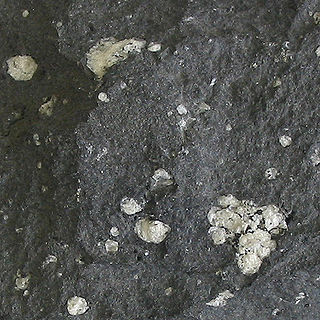
Andesite is a volcanic rock of intermediate composition. In a general sense,it is the intermediate type between silica-poor basalt and silica-rich rhyolite. It is fine-grained (aphanitic) to porphyritic in texture,and is composed predominantly of sodium-rich plagioclase plus pyroxene or hornblende.

Anorthosite is a phaneritic,intrusive igneous rock characterized by its composition:mostly plagioclase feldspar (90–100%),with a minimal mafic component (0–10%). Pyroxene,ilmenite,magnetite,and olivine are the mafic minerals most commonly present.

Peridotite ( PERR-ih-doh-tyte,pə-RID-ə-) is a dense,coarse-grained igneous rock consisting mostly of the silicate minerals olivine and pyroxene. Peridotite is ultramafic,as the rock contains less than 45% silica. It is high in magnesium (Mg2+),reflecting the high proportions of magnesium-rich olivine,with appreciable iron. Peridotite is derived from Earth's mantle,either as solid blocks and fragments,or as crystals accumulated from magmas that formed in the mantle. The compositions of peridotites from these layered igneous complexes vary widely,reflecting the relative proportions of pyroxenes,chromite,plagioclase,and amphibole.
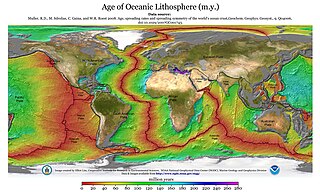
Oceanic crust is the uppermost layer of the oceanic portion of the tectonic plates. It is composed of the upper oceanic crust,with pillow lavas and a dike complex,and the lower oceanic crust,composed of troctolite,gabbro and ultramafic cumulates. The crust overlies the rigid uppermost layer of the mantle. The crust and the rigid upper mantle layer together constitute oceanic lithosphere.
Isotope geochemistry is an aspect of geology based upon the study of natural variations in the relative abundances of isotopes of various elements. Variations in isotopic abundance are measured by isotope ratio mass spectrometry,and can reveal information about the ages and origins of rock,air or water bodies,or processes of mixing between them.
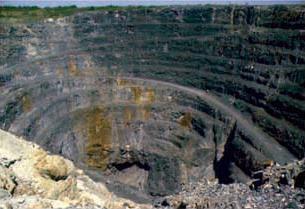
Volcanogenic massive sulfide ore deposits,also known as VMS ore deposits,are a type of metal sulfide ore deposit,mainly copper-zinc which are associated with and created by volcanic-associated hydrothermal events in submarine environments.
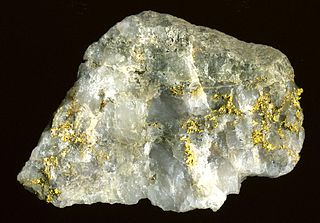
Various theories of ore genesis explain how the various types of mineral deposits form within Earth's crust. Ore-genesis theories vary depending on the mineral or commodity examined.

A layered intrusion is a large sill-like body of igneous rock which exhibits vertical layering or differences in composition and texture. These intrusions can be many kilometres in area covering from around 100 km2 (39 sq mi) to over 50,000 km2 (19,000 sq mi) and several hundred metres to over one kilometre (3,300 ft) in thickness. While most layered intrusions are Archean to Proterozoic in age,they may be any age such as the Cenozoic Skaergaard intrusion of east Greenland or the Rum layered intrusion in Scotland. Although most are ultramafic to mafic in composition,the Ilimaussaq intrusive complex of Greenland is an alkalic intrusion.
In geology,igneous differentiation,or magmatic differentiation,is an umbrella term for the various processes by which magmas undergo bulk chemical change during the partial melting process,cooling,emplacement,or eruption. The sequence of magmas produced by igneous differentiation is known as a magma series.
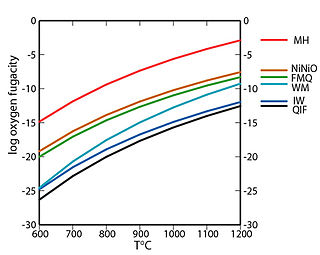
In geology,a redox buffer is an assemblage of minerals or compounds that constrains oxygen fugacity as a function of temperature. Knowledge of the redox conditions (or equivalently,oxygen fugacities) at which a rock forms and evolves can be important for interpreting the rock history. Iron,sulfur,and manganese are three of the relatively abundant elements in the Earth's crust that occur in more than one oxidation state. For instance,iron,the fourth most abundant element in the crust,exists as native iron,ferrous iron (Fe2+),and ferric iron (Fe3+). The redox state of a rock affects the relative proportions of the oxidation states of these elements and hence may determine both the minerals present and their compositions. If a rock contains pure minerals that constitute a redox buffer,then the oxygen fugacity of equilibration is defined by one of the curves in the accompanying fugacity-temperature diagram.
Partial melting is the phenomenon that occurs when a rock is subjected to temperatures high enough to cause certain minerals to melt,but not all of them. Partial melting is an important part of the formation of all igneous rocks and some metamorphic rocks,as evidenced by a multitude of geochemical,geophysical and petrological studies.

Igneous rock,or magmatic rock,is one of the three main rock types,the others being sedimentary and metamorphic. Igneous rocks are formed through the cooling and solidification of magma or lava.

Terry Ann Plank is an American geochemist,volcanologist and professor of earth science at Columbia College,Columbia University,and the Lamont Doherty Earth Observatory. She is a 2012 MacArthur Fellow and member of the National Academy of Sciences. Her most prominent work involves the crystal chemistry of lava minerals in order to determine magma ages and movement,giving clues to how quickly magma can surface as lava in volcanoes. Most notably,Plank is known for her work establishing a stronger link between the subduction of ocean sediments and volcanism at ocean arcs. Her current work can be seen at her website.
Plank states that her interest in volcanoes began when her Dartmouth professor took her and other students to Arenal volcano in Costa Rica. He had them sit and have lunch while on top of a slow-moving lava flow and while watching bright red goops of lava crack out from their black casings. "It was totally cool,how could you not like that?" Plank recalled the event to State of the Planet,an Earth Institute News source at Columbia University.
A continental arc is a type of volcanic arc occurring as an "arc-shape" topographic high region along a continental margin. The continental arc is formed at an active continental margin where two tectonic plates meet,and where one plate has continental crust and the other oceanic crust along the line of plate convergence,and a subduction zone develops. The magmatism and petrogenesis of continental crust are complicated:in essence,continental arcs reflect a mixture of oceanic crust materials,mantle wedge and continental crust materials.
Sarah-Jane Barnes is a British-Canadian geologist,who is a professor at the Universitédu Québec àChicoutimi and director of LabMaTer.
Janet Margaret Hergt is an Australian geochemist. She is a Redmond Barry Distinguished Professor in the School of Geography,Earth and Atmospheric Sciences at the University of Melbourne,Victoria,Australia. The main focus of her research has been in the chemical analysis of rocks and minerals to explore the exquisite record of Earth processes preserved within them. Hergt is best known for her geochemical investigations of magmatic rocks although she has employed similar techniques in interdisciplinary projects including areas of archaeological and biological science.

The Dharwar Craton is an Archean continental crust craton formed between 3.6-2.5 billion years ago (Ga),which is located in southern India and considered as the oldest part of the Indian peninsula.
References
- 1 2 3 "Members". uniweb.uottawa.ca.
- 1 2 "Previous International Exchange Lecturers | SEG (Society of Economic Geologists)". www.segweb.org.
- 1 2 "各賞受賞者・表彰者 | 資源地質学会 – The Society of Resource Geology".
- ↑ "Academy of Science | The Royal Society of Canada". rsc-src.ca.
- ↑ "Mineralogical Society of America" (PDF).
- 1 2 3 "Career Profile: Professor Keiko Hattori". The Fulcrum. October 18, 2021.
- ↑ Hattori, Keiko; Muehlenbachs, Karlis (August 10, 1982). "Oxygen isotope ratios of the Icelandic crust". Journal of Geophysical Research: Solid Earth. 87 (B8): 6559–6565. Bibcode:1982JGR....87.6559H. doi:10.1029/JB087iB08p06559 – via CrossRef.
- ↑ McCullough, Brian (September 22, 2018). "uOttawa doctoral students researching exciting aspects of geological science". The Ottawa Citizen. p. E4.
- 1 2 "Distinguished University Professor". About us.
- ↑ "The Ottawa-Carleton Geoscience Centre". www3.carleton.ca.
- ↑ Deachman, Bruce (October 12, 2006). "Blast of such magnitude requires co-ordination, plenty of TNT". The Ottawa Citizen. p. 3.
- ↑ "Mineralogical Society of America - President's Letter" (PDF).
- ↑ "Economic Geology".
- ↑ "Processes and Selection Committees".
- ↑ "Subduction of mantle wedge peridotites: Evidence from the Higashi-akaishi ultramafic body in the Sanbagawa metamorphic belt".
- ↑ "Osmium-isotope ratios of platinum-group minerals associated with ultramafic intrusions: Os-isotopic evolution of the oceanic mantle".
- ↑ "Keiko Hattori". scholar.google.ca.
- ↑ Hattori, Keiko; Campbell, Finley A.; Krouse, H. Roy (March 2, 1983). "Sulphur isotope abundances in Aphebian clastic rocks: implications for the coeval atmosphere". Nature. 302 (5906): 323–326. Bibcode:1983Natur.302..323H. doi:10.1038/302323a0. S2CID 4338358 – via www.nature.com.
- ↑ Hattori, Keiko; Krouse, H. Roy; Campbell, Finley A. (1983). "The Start of Sulfur Oxidation in Continental Environments: About 2.2 × 109 Years Ago". Science. 221 (4610): 549–551. doi:10.1126/science.221.4610.549. PMID 17830956. S2CID 19381660.
- ↑ Hattori, Keiko; Cameron, Eion M. (January 2, 1986). "Archaean magmatic sulphate". Nature. 319 (6048): 45–47. Bibcode:1986Natur.319...45H. doi:10.1038/319045a0. S2CID 4342100 – via www.nature.com.
- 1 2 "High-sulfur magma, a product of fluid discharge from underlying mafic magma: Evidence from Mount Pinatubo, Philippines".
- ↑ "Barite-celestine intergrowths in Archean plutons: the product of oxidizing hydrothermal activity related to alkaline intrusions" (PDF).
- ↑ Hattori, Keiko; Hart, Stanley R. (December 1, 1991). "Osmium-isotope ratios of platinum-group minerals associated with ultramafic intrusions: Os-isotopic evolution of the oceanic mantle". Earth and Planetary Science Letters. 107 (3): 499–514. Bibcode:1991E&PSL.107..499H. doi:10.1016/0012-821X(91)90096-Z – via ScienceDirect.
- ↑ Hattori, Keiko; Cabri, Louis J.; Hart, Stanley R. (March 1, 1991). "Osmium isotope ratios of PGM grains associated with the Freetown Layered Complex, Sierra Leone, and their origin". Contributions to Mineralogy and Petrology. 109 (1): 10–18. Bibcode:1991CoMP..109...10H. doi:10.1007/BF00687197. S2CID 73638764 – via Springer Link.
- ↑ "Origin of platinum group mineral nuggets inferred from an osmium isotope study" (PDF).
- ↑ Hattori, Keiko; Burgath, Klaus-Peter; Hart, Stanley R. (June 2, 1992). "Os-isotope study of platinum-group minerals in chromitites in Alpine-type ultramafic intrusions and the associated placers in Borneo". Mineralogical Magazine. 56 (383): 157–164. Bibcode:1992MinM...56..157H. doi:10.1180/minmag.1992.056.383.02. S2CID 128816288 – via Cambridge University Press.
- ↑ Hattori, Keiko; Takahashi, Yoshio; Augé, Thierry (August 30, 2010). "Mineralogy and origin of oxygen-bearing platinum-iron grains based on an X-ray absorption spectroscopy study". American Mineralogist. 95 (4): 622. Bibcode:2010AmMin..95..622H. doi:10.2138/am.2010.3391. hdl: 10393/19591 – via ruor.uottawa.ca.
- ↑ "Serpentinites: Essential Roles in Geodynamics, Arc Volcanism, Sustainable Development, and the Origin of Life".
- ↑ "Volcanic fronts form as a consequence of serpentinite dehydration in the forearc mantle wedge".
- 1 2 Hattori, Kéiko H.; Guillot, Stéphane (September 2, 2007). "Geochemical character of serpentinites associated with high- to ultrahigh-pressure metamorphic rocks in the Alps, Cuba, and the Himalayas: Recycling of elements in subduction zones: GEOCHEMISTRY OF SERPENTINITES". Geochemistry, Geophysics, Geosystems. 8 (9): n/a. doi:10.1029/2007GC001594. S2CID 54683093 – via CrossRef.
- ↑ Hattori, Keiko; Takahashi, Yoshio; Guillot, Stephane; Johanson, Bo (December 1, 2005). "Occurrence of arsenic (V) in forearc mantle serpentinites based on X-ray absorption spectroscopy study". Geochimica et Cosmochimica Acta. 69 (23): 5585–5596. Bibcode:2005GeCoA..69.5585H. doi:10.1016/j.gca.2005.07.009 – via ScienceDirect.
- 1 2 de Hoog, J. C. M.; Hattori, K. H.; Hoblitt, R. P. (February 1, 2004). "Oxidized sulfur-rich mafic magma at Mount Pinatubo, Philippines". Contributions to Mineralogy and Petrology. 146 (6): 750–761. Bibcode:2004CoMP..146..750D. doi:10.1007/s00410-003-0532-4. S2CID 129232046 – via Springer Link.
- ↑ Wang, Jian; Hattori, Kéiko H.; Kilian, Rolf; Stern, Charles R. (May 1, 2007). "Metasomatism of sub-arc mantle peridotites below southernmost South America: reduction of fO2 by slab-melt". Contributions to Mineralogy and Petrology. 153 (5): 607–624. Bibcode:2007CoMP..153..607W. doi:10.1007/s00410-006-0166-4. S2CID 55673386 – via Springer Link.
- ↑ Hattori, Kéiko H.; Keith, Jeffrey D. (December 1, 2001). "Contribution of mafic melt to porphyry copper mineralization: evidence from Mount Pinatubo, Philippines, and Bingham Canyon, Utah, USA". Mineralium Deposita. 36 (8): 799–806. Bibcode:2001MinDe..36..799H. doi:10.1007/s001260100209. S2CID 128559718 – via Springer Link.
- ↑ Viala, M.; Hattori, K. (April 1, 2021). "Hualgayoc mining district, northern Peru: Testing the use of zircon composition in exploration for porphyry-type deposits". Journal of Geochemical Exploration. 223: 106725. Bibcode:2021JCExp.22306725V. doi:10.1016/j.gexplo.2021.106725. S2CID 234257450 – via ScienceDirect.
- ↑ "Using the High Mobility of Palladium in Surface Media in Exploration for Platinum Group Element Deposits: Evidence from the Lac des Iles Region, Northwestern Ontario" (PDF).
- ↑ Hattori, Kéiko H.; Hamilton, Stewart (December 1, 2008). "Geochemistry of peat over kimberlites in the Attawapiskat area, James Bay Lowlands, northern Canada". Applied Geochemistry. 23 (12): 3767–3782. Bibcode:2008ApGC...23.3767H. doi:10.1016/j.apgeochem.2008.09.012 – via ScienceDirect.